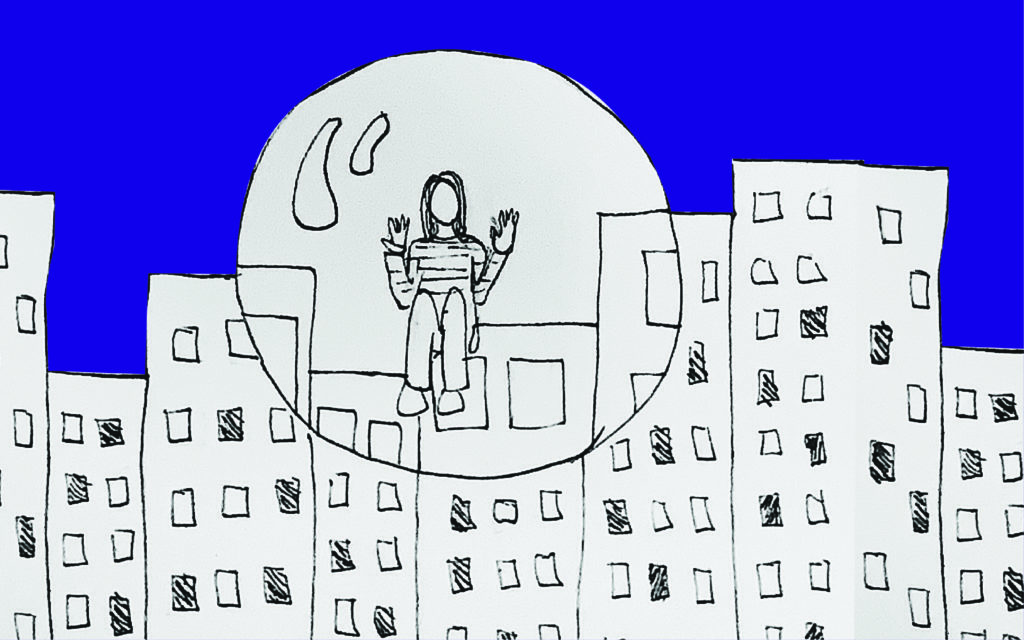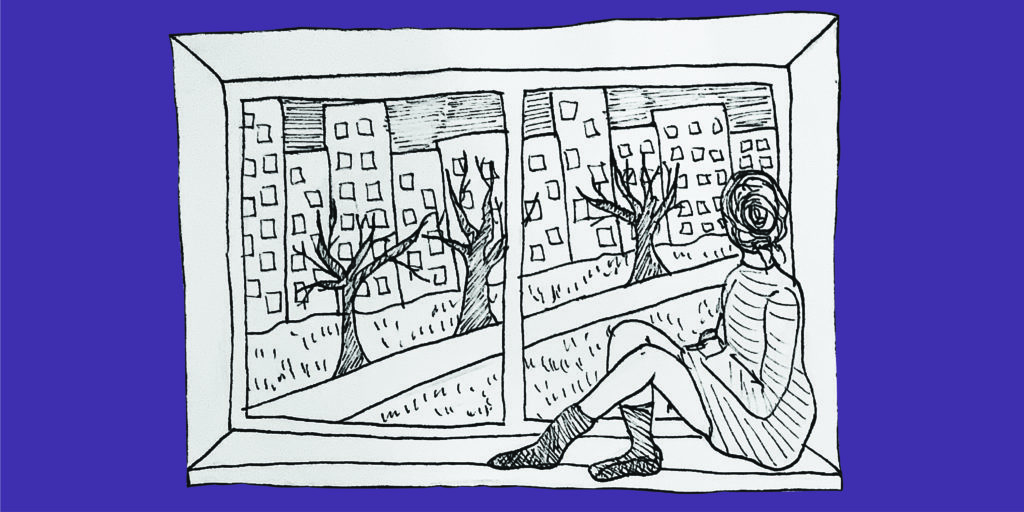I watched the leaves grow back on the trees on the street below my window. I craned my neck to see them from the top story of my New York City dorm overlooking the city. I could only spot four of them. And even so, they appeared microscopic. I moved here in January of 2021 when the air was too cold to enjoy the outdoors and when the masses were trapped indoors. Peering out the black industrial-looking windowpane, I saw my reflection appear, blurring into the city lights, like some sort of modern-day Kandinsky. I am taken back to my childhood, looking out the car windows smudged from my old dog’s nose. He used to pry his head out into the fresh air while dripping slobber all over. I am taken back to my side porch with screens instead of windows that allow indoor and fresh air to meet somewhere in the middle. I am taken back to when I could feel the outdoors take over my body whenever I pleased. But suddenly, the world existed in the confine of our own spaces. The locks on our doors tightened, leaving us isolated from the world around us.
“They think they can keep it out by locking themselves in,” an unnamed Montana State College student said during the Spanish Influenza outbreak in 1918. The reality of isolation has troubled past generations similarly. The language describing isolation has also remained quite similar despite generational differences. Samuel Pepys uses words such as “melancholy,” “sorrow,” and “fear” in his diaries written during the bubonic plague, words that capture these current events vividly. Countless examples from past pandemics detail such similar sentiments to those of today. They describe the peril of existence in such unnerving times. They describe being physically isolated and feeling isolated. How do our lives remain anywhere near normal when isolated in a sphere of “melancholy,” “sorrow,” and “fear”? It’s not like we can simply keep going, keep working, keep creating, keep reading, keep learning, keep acting normal. We are so consumed by our misery. Our only true desire is escape.
I cherished that window. For a while, it was my only escape from the four walls of my room and my windowless kitchen which was no more than 100 square feet. I watched people walking along the sidewalk, but I was too far up to make out the words. I listened to kids blasting music, the drum beat carrying 15 stories high. Somehow I could feel it reverberating in my chest like I was standing right next to them. I felt the rain fall on my fingertips, something tangible for once. Storms rarely emerged in the city. Not like they would in my Pennsylvania suburb. The faint smell of rain lingered days after it fell. Now, I smelled pizza from the corner shop waft up to my dorm room. Sitting there, I felt stuck in a place that I should never feel stuck in.
I tried to keep up as the world moved around me outside that window. I took on various hobbies. Most of them only lasted a few weeks, if that. For a while, I reverted to my childhood summer days and used old string to make friendship bracelets. I would look up extravagant patterns using all sorts of different colors. I’d tie the string into sunflowers and hearts and tulips and zig zags, you name it. I’d move down the line, tying knot after knot, colors shifting every few knots. Oftentimes, I would not even finish them or would never give them to my friends. The strings sat in a pile on my desk until I eventually put them in a drawer. As I sat there with string tracing through my fingers, I could almost smell the freshly cut grass, feel the sun hitting my face, and hear Spongebob reruns bellow out of my living room.
Now, I get small doses of these old frequent feelings. I moved on to crocheting, a much more useful skill. I was not very good. My second Covid vaccine may have played a part in my subpar crocheting skills. Having left my dorm for walks and only a handful of other times, that breath of New York City’s uninviting air felt refreshing. My journey was one of the few glimpses of contact I had in a long time. After the further isolating effects of my vaccine wore off, I quickly moved on to making rings out of wire and beads. I kept trying to find some sort of outlet, something to transcend me out of my dorm and into the movement outside my window.
Zadie Smith’s Intimations divulges into her experience during the early months of the pandemic. In her raw reflection, she remembers the inspiration for Vladimir Nabokov’s classic, Lolita. Nabokov was inspired by a Jardin des Plantes article about the first ape to draw. While his claims are farfetched and likely had no part in the making of Lolita, Smith was struck. “The ape is caged by its nature, by its instincts, by its circumstance,” Zadie Smith says. She interprets this ape in relation to gender identity: how these intersect in a conversation of gender and how the virus, or the “global humbling,” is genderless. The virus doesn’t care about gender identity. Struck with collective isolation, we all find ourselves surrounded by fear and hurt while simultaneously surrounded by no one. While Smith interprets the ape in terms of gender, I can’t seem to think about anything but isolation. Her ideas depict our collective response to isolation during this global humbling. Once caged, we are plagued by ourselves, feeling trapped, feeling too still for comfort. The cage itself does not make us feel trapped. Our nature, our instincts, our circumstance does.
In 2020, the world fell into lockdown, leaving many trapped by their nature, instincts, and circumstances. I felt it, some sort of purgatory when sitting in front of that cage-like window. Like I was so close to the real thing, waiting to see what the real thing truly was, but getting stuck just before reaching it. I sat in stillness. It felt like I sat there until I had to move back home for the summer.
I stacked my boxes in the center of my room. For days, I had to climb around them, jumping over them just to grab a snack. The downstairs neighbors I never met, could probably hear me. Good thing they didn’t know it was me. I got one last bagel then my dad drove me home.
I found myself back in my childhood backyard again, soaking every sunray into my skin. SPF 80 did not keep my skin from turning pink, but my return to the fresh air filled me with ease. While the world still moved slowly, I finally felt serene instead of stuck. Surrounded by people I love with a bird chirping in my ear, I felt less trapped. Maggie Nelson describes the panic many felt in the early stages of the pandemic. Many were suffering, others were despondent, everyone was afraid. But somehow, at the same time, the outside “look[ed] like nothing but an empty street, flat—if not radiant—with the new calm.” Finding ourselves in fear and isolation, we react. With some dichotomy between a sense of calm and one of calamity, we get pulled in different directions. We never quite know if our body is quiet or on the verge of distress, even a year later. Even after those early stages, the same feelings persist. In suburban Pennsylvania, I felt that radiant calm. Isolation there was much different than in one of the fastest-paced cities in the world. I felt melancholy and fear much more in New York. I felt much more trapped in a dorm room than in the comfort of my backyard. I did not have the same access in the suburbs. Realistically, I didn’t even have more access to the city when restrictions still loomed. I felt more content with my loneliness in a place that never normally has much access.
Soon enough, I had to pack up my bags again. The car was as full as it used to be for our family vacations. A few less flip-flops and Wildwood t-shirts but the same hands stuffing the trunk to the brim. I stared out the window on the drive up, pushing pillows away from my head that kept falling further with every bump we hit. The highway-rail looks blurry. I can’t quite figure out if it’s because the car is moving at 70 mph or because my eyes are glazed over, still, in thought. What will my life look like now? How do you determine if a place is right for you when the entire world looks different, moves at a different pace?
When I looked out that window freshman year, everything moved in slow motion, but the world kept going. I thought a pandemic might stop everyone from moving. I was wrong. Looking out at the normally bustling New York City, I realized nothing could keep this city from moving, even if it was at a slower pace. I sat back and observed. Alone. Still. Somewhere between tranquil and paralyzed. My heart fills with promise as I venture back, but a part of me feels stuck behind that window; I think it always will. That beautiful, beautiful window.
When I arrived back in the city and unlocked the door to my first apartment, I noticed the measly window facing a gray wall and overlooking the trash room in my new bedroom. Somehow though, this feels different, feels better. I could feel the life in this apartment. I could feel the life outside of this apartment.

This time around, I stepped outside my own bubble and into the life of the city. It did not all fall into place overnight, though. I had a job, one that ended up teaching me more about the real world than I ever could have expected from a job at a cookie shop. It got me out of my apartment and kept me busier than I ever could be in my dorm room. Still, my classes were online for the first two weeks of school, transporting me back behind my dorm room window. My space felt less industrial, at least. No more concrete floors and fake wood and a sterile white kitchenette. Instead, I was surrounded by hardwood floors and brick walls and elegant molding along the ceiling. I tiptoed out of isolation, slowly, steadily.
And slowly, steadily, it felt like every cliché New York City-based movie and tv show. The ones that romanticize nightlife and dancing in the streets and laughing with your friends while drinking wine and picture-perfect outfits and never getting sweaty or harassed on the subway and happiness and purpose. I met my friends in the most paradoxical, destiny-ridden fashion. We found a Gilmore Girls-like diner where the staff knew our names and would bring extra syrup without being asked. We frequented cafés intending to do homework but would really chat and read for hours. We loved walking places. Some days we found new bookstores or stationery shops. Other times we had movie nights, dinner parties, study sessions, and collage nights. Collaging was another of my brief hobbies in my dorm. And now, I sat on a dorm room floor, surrounded by some of my best friends, creating alongside them. With them, I found the perfect balance of movement and stillness, something I had been searching especially hard for during the pandemic. Mask still in hand, I kept going, and for the first time in a while, I felt content in the pace of my life. •




